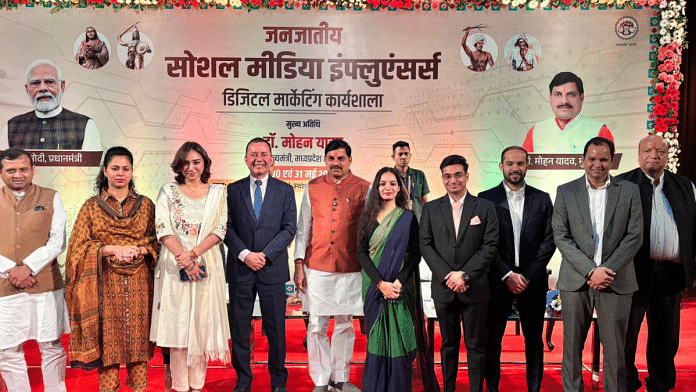Bhopal: The Madhya Pradesh government has rolled out a digital literacy programme for tribal influencers to equip them with skills to monetise social media, promote government policies and provide accurate information on initiatives such as Operation Sindoor among tribal communities.
The initiative came after an increase in misinformation on social media following the Pahalgam terror attack and the subsequent Indian strike on terror infrastructure in Pakistan and Pakistan-occupied Kashmir.
The government called over 200 influencers from across the state for a two-day workshop in Bhopal, where they learnt how to build their presence on social media, create culturally-rooted content to appeal to a global audience, promote government initiatives, get feedback from the ground, and eventually cultivate tribal youth as ambassadors of government institutions.
“The move is a means to impart digital literacy that will allow these tribal youths to become a part of mainstream voices while also becoming financially independent by monetising their own content and collaborating with brands while asserting and promoting their tribal identity,” Laxman Singh Markham, additional commissioner of the MP Tribal Research Institute and additional secretary to Chief Minister Mohan Yadav, told ThePrint.
A senior MP official said the initiative will also help them serve as the government’s voice in the tribal community and counter misinformation and divisive content, such as the demand for a separate ‘Bhilistan’, which officials said had gained momentum after Operation Sindoor.
“Several studies also reflected an increase in such divisive content targeted at the tribal community to foster unrest, while distorting the message of Operation Sindoor, which is yet to reach the grassroots level,” the government official told ThePrint.
Also Read: Time to ‘retire lame horse’—Rahul Gandhi hints at massive revamp of MP Congress unit
Ramping up tribal outreach
Madhya Pradesh has the largest tribal population in the country. According to the 2011 Census, tribals accounted for approximately 15.34 million, or 21.1 percent of the state’s population, with 48 of the total 230 assembly seats reserved for tribals.
Over the past few years, the Bharatiya Janata Party (BJP) government has significantly ramped up its tribal outreach with memorials and museums highlighting the role of Adivasi leaders such as Shankar Shah and Raghunath Shah in the freedom struggle.
Railway stations and bus stops have been named after tribal icons like Rani Kamlapati and Tantya Bhil, while mahua, a staple drink of the tribals, was legalised in the state and tagged as heritage liquor.
This came after a shift in the voting patterns of Scheduled Tribe and Scheduled Caste voters was seen as a major reason for the BJP briefly losing power to the Kamal Nath-led Congress government in the 2018 assembly polls.
But the move has come under sharp criticism from Congress MLA Hiralal Alawa, who called it a BJP government tactic to rope in young tribal minds to further its party agenda.
“This is not the first time the BJP has relied on young tribal minds and is attempting to use them to further their party’s agenda. Just before the assembly election, the government had roped in young influencers, giving them Rs 30,000 to Rs 40,000 to promote schemes such as Ladli Behna Yojana,” Alawa told ThePrint.
“A young person, who otherwise follows these influencers and believes their content depicts authentic information, will fall for the BJP’s narrative created by such influencers. Essentially, these influencers are becoming a party to misleading society,” he added.
But Markham defended the move, calling it a step towards unifying various tribal clans under one tribal identity.
“This should not be viewed from the lens of politics; it’s a means to unify the various tribal clans under one tribal identity,” Markham told ThePrint.
The two-day workshop saw digital marketing experts share an insider’s perspective on digital marketing and its potential as a source of revenue for these influencers.
Shruti Yadav, who works for Amazon and has over a decade of experience in digital marketing, was one of the prominent speakers at the event.
“Today, prominent influencers earn anywhere between Rs 2 lakh and Rs 4 lakh per reel and per story through social media apps such as Instagram, but it has taken them years to generate that following. Our idea is to not just focus on the technical aspects of creating a website, promoting products and onloading their products on platforms such as Amazon and Meesho, but also on how to communicate with brands, among other things,” said Yadav.
For Priyanka Tomar, a tribal from Alirajpur’s Kathiwada block, the workshop was a great way to learn how to further increase her reach and social media engagement.
Since starting in 2018, Tomar has grown into a prominent tribal influencer, creating videos on lesser-known tribal customs and traditions. With one lakh followers on Instagram, Tomar had been engaged by the Election Commission to ensure tribal voters return to their hometowns to vote.
The government’s publicity department approached Tomar ahead of the 2023 election to create awareness on the impact of the Ladli Behna Yojana rolled out by then Chief Minister Shivraj Singh Chouhan.
“I have also done two other promotional videos, one of which was for ITI Kukshi. During the workshop, we were given valuable inputs on increasing engagement, the audience across various social media platforms and how to increase one’s earnings,” said Tomar.
“We were also told about how we can promote products made by the women-led Self Help Groups (SHGs) and ensure correct information regarding major events like Operation Sindoor reaches the ground.”
(Edited by Sugita Katyal)
Also Read: Why BJP can’t sack MP minister Vijay Shah for demeaning Colonel Sofiya Qureshi






